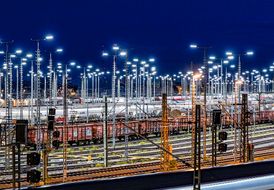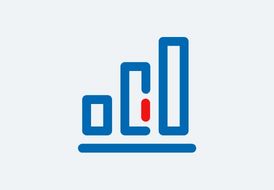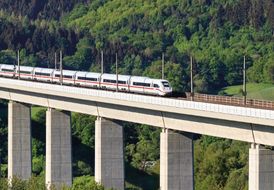Development in the year under review
- Very positive market environment after burdens from the Covid-19 pandemic in 2020.
- Strong improvement in profits, particularly in air and ocean freight.
- Extensive measures to improve efficiency and digitalization.
DB SCHENKER | 2021 | 2020 | Change | 2019 | ||
absolute | % | |||||
Customer satisfaction (SI) | 68 | 74 | –6 | – | 71 | |
Land transport shipments (million) | 110.7 | 108.2 | +2.5 | +2.3 | 107.1 | |
Air freight volume (export) (thousand t) | 1,438 | 1,094 | +344 | +31.4 | 1,186 | |
Ocean freight volume (export) (thousand TEU) | 2,003 | 2,052 | –49 | –2.4 | 2,294 | |
Total revenues (€ million) | 23,443 | 17,671 | +5,772 | +32.7 | 17,091 | |
External revenues (€ million) | 23,371 | 17,601 | +5,770 | +32.8 | 17,018 | |
Gross profit margin (%) | 31.2 | 35.2 | –4.0 | – | 36.1 | |
EBITDA adjusted (€ million) | 1,845 | 1,307 | +538 | +41.2 | 1,082 | |
EBIT adjusted (€ million) | 1,248 | 711 | +537 | +75.5 | 538 | |
EBIT margin (adjusted) (%) | 5.3 | 4.0 | +1.3 | – | 3.1 | |
Gross capital expenditures (€ million) | 844 | 817 | +27 | +3.3 | 662 | |
Employees as of Dec 31 (FTE) | 76,114 | 74,161 | +1,953 | +2.6 | 76,153 | |
Annual average employees (FTE) | 74,744 | 74,373 | +371 | +0.5 | 76,047 | |
Employee satisfaction (SI) | – | 3.9 | – | – | – | |
Share of women as of Dec 31 (%) | 36.5 | 36.3 | +0.2 | – | 36.1 | |
Specific greenhouse gas emissions (land transport) compared to 2006 (based on tkm) (%) | –31.6 | –26.0 | –5.6 | – | –24.0 | |
Specific greenhouse gas emissions (air freight) compared to 2006 (based on tkm) (%) | –17.4 | –15.9 | –1.5 | – | –9.1 | |
Specific CO₂ emissions (ocean freight) compared to 2006 (based on tkm) (%) | –68.4 | –67.6 | –0.8 | – | –64.3 | |
Customer satisfaction declined significantly. The main drivers were capacity bottlenecks, closed ports and steep price increases. Customers in 18 countries were surveyed to assess customer satisfaction. The survey is carried out annually, inviting more than 200,000 participants.
Volume development reflected the overall macroeconomic recovery. Volumes increased significantly, particularly in air freight, and in some cases they rose above pre-pandemic levels. In addition to the positive market effects, DB Schenker was also able to profit from its own measures, such as ensuring transport activities at an early stage.
The economic development, driven by air and ocean freight, was also very encouraging: operating profit figures rose significantly in all regions. As a result, gross profit also improved noticeably (+17.6%). Adjusted for exchange rates, the increase was even stronger.
Income development was very positive, driven by strong revenue growth:
- Revenues increased significantly as a result of growth in volumes. Higher freight rates also had a positive effect, particularly in air and ocean freight. Negative currency effects, in contrast, had a revenue-reducing effect.
- Other operating income (–15.1%/€ –41 million) fell significantly at a low level. This was due, among other things, to lower income from Covid-19 support and for operating leases.
Expenses were driven, in part, by volume and freight-rate developments. In contrast, the effects of measures to improve productivity had a lowering effect:
- The cost of materials (+40.7%/€ +4,718 million) increased significantly due to the development of freight rates and increased volumes, particularly in air freight. Exchange rate effects and declines in other business areas, on the other hand, had an expense-reducing effect.
- Personnel expenses increased (+7.6%/€ +260 million), due in part to growth in volumes. Exchange rate effects, in contrast, had an expense-reducing effect.
- The significant increase in other operating expenses (+13.4%/€ +217 million) was also mainly driven by increased volumes. Exchange rate effects, in contrast, had an expense-reducing effect.
- Depreciation (+0.2%/€ +1 million) was at the same level as in the previous year. Higher depreciation due to increased capital expenditures (including leasing) was almost completely eliminated by exchange rate effects that reduced expenses.
Capital expenditure activity increased. The increase was mainly due to leasing activities. The focus of capital expenditures continued to be on the Europe and Asia regions. Adjusted for exchange rates, the increase was less significant.
Due to adjustments driven by growth in volumes, the number of employees was slightly above the level as of December 31, 2021. On an annual average basis, the number of employees was at the previous year’s level.
As of December 31, 2021, the share of women had increased slightly.
Specific CO₂ emissions were further reduced in comparison with the reference year 2006:
- Land transport once again recorded an increase in volume and emissions, with a significant shift to direct transport, including the integration of port/airport feeder services from other lines of business (air, sea, contract logistics). This in turn increased the average weight of shipments and significantly improved greenhouse gas efficiency.
- The trend towards freight aircraft, which was observed in the wake of the Covid-19 pandemic, continued in 2021 and reduced greenhouse gas efficiency. However, the corresponding effects were more than compensated for by the strong volume increase.
- In ocean freight, the trend towards cleaner fuels with increased greenhouse gas efficiency largely offset the specific reduction of greenhouse gases, with only a small improvement and slightly lower overall volumes.
- Further increase in demand.
- Quality improvements with positive effects.
- Further increase in demand for the digital platforms Connect4land and Drive4Schenker.
| LAND TRANSPORT LINE OF BUSINESS | 2021 | 2020 | Change | 2019 | ||
absolute | % | |||||
Land transport shipments (million) | 110.7 | 108.2 | +2.5 | +2.3 | 107.1 | |
Total revenues (€ million) | 7,517 | 6,716 | +801 | +11.9 | 7,125 | |
External revenues (€ million) | 7,452 | 6,651 | +801 | +12.0 | 7,058 | |
EBITDA adjusted (€ million) | 300 | 339 | –39 | –11.5 | 341 | |
EBIT adjusted (€ million) | 113 | 158 | –45 | –28.5 | 172 | |
Employees as of Dec 31 (FTE) | 23,255 | 21,807 | +1,448 | +6.6 | 21,811 | |
Demand for land transport increased, driven by growth in direct, system and special transport services. In contrast, declines in package transport had a dampening effect.
Economic development was weak. Operating profit figures dropped as a result of a noticeable increase in expenses. This outweighed the positive profit development.
- Revenues increased significantly, due in part to volume-related factors. Adjusted for exchange rates, the increase was somewhat less significant.
- Other operating income fell slightly as a result of lower state aid for Covid-19, primarily in Germany, Austria, France and Sweden.
Trends in expenses were driven by rising volumes in the cost-intensive areas of direct, system and special transport services. Compared to income, the increase was significantly stronger:
- The costs of materials increased noticeably in line with demand. Rising prices and exchange rate effects exacerbated this trend.
- Other operating expenses increased due to the reclassification of IT expenses within the business unit with no effect on income.
- Personnel expenses increased due to growth in volumes and exchange rates.
The number of employees increased significantly, partly due to growth in volumes.
- Strong recovery in demand for air freight.
- Capacity bottlenecks and pandemic-related uncertainties suppress growth in ocean freight.
- Significant increase in freight rates.
- Air freight: various measures implemented to ensure transport operations, standardization, and productivity improvements.
- Ocean freight: implementation of projects to improve efficiency and optimize organization worldwide.
| AIR AND OCEAN FREIGHT LINE OF BUSINESS | 2021 | 2020 | Change | 2019 | ||
absolute | % | |||||
Air freight volume (export) (thousand t) | 1,438 | 1,094 | +344 | +31.4 | 1,186 | |
Ocean freight volume (export) | 2,003 | 2,052 | –49 | –2.4 | 2,294 | |
Total revenues (€ million) | 12,962 | 8,228 | +4,734 | +57.5 | 7,218 | |
External revenues (€ million) | 12,957 | 8,223 | +4,734 | +57.6 | 7,213 | |
EBITDA adjusted (€ million) | 1,094 | 511 | +583 | +114 | 342 | |
EBIT adjusted (€ million) | 1,028 | 448 | +580 | +129 | 287 | |
Employees as of Dec 31 (FTE) | 13,609 | 13,185 | +424 | +3.2 | 13,964 | |
The performance development differed for air and ocean freight.
- In air freight, the trend was very positive, with volumes rising above the pre-pandemic level, driven by higher demand for the transport of electronics, automotive and medical goods. A temporary, large-scale shift in transport demand from ocean freight had a supporting effect.
- For ocean freight, volumes were slightly below the low level of the previous year. Equipment and capacity shortages, alongside the tense market situation due to Covid-19, were only partially offset by volume growth in the Asia/Pacific region and temporary recovery trends.
The economic development was very encouraging: the adjusted profit figures improved due to the significant increase in income:
- Revenue increased significantly, mainly due to the growth in freight rates. Volume growth also had a very positive effect in air freight. Adjusted for exchange rates, the increase was even stronger.
- Other operating income was virtually unchanged. Volume and price trends in air and ocean freight offset each other almost entirely.
In terms of expenses, volume growth in air freight and the increase in freight rates had a notable impact:
- The costs of materials increased significantly, mainly as a result of higher volumes in air freight and higher freight rates. Exchange rate effects, in contrast, had an expense-reducing effect.
- Other operating expenses increased due to the reclassification of IT expenses within the business unit with no effect on income.
- Personnel expenses increased as a result of a higher number of employees, partly due to growth in volumes. Exchange rate effects, in contrast, had an expense-reducing effect.
The number of employees increased as a result of the increase in volumes. More complex work processes due to Covid-19 resulted in additional new hires in ocean freight.
- Significant recovery of business activities following stricter restrictions as a result of the Covid-19 pandemic.
- The growth drivers are Asia/Pacific and America – a lack of semiconductors is slowing development in Europe.
- Productivity improvement measures are being implemented.
| CONTRACT LOGISTICS LINE OF BUSINESS | 2021 | 2020 | Change | 2019 | ||
absolute | % | |||||
Warehouse space (million m²) | 8.4 | 8.8 | –0.4 | –4.5 | 8.4 | |
Total revenues (€ million) | 2,964 | 2,715 | +249 | +9.2 | 2,734 | |
External revenues (€ million) | 2,963 | 2,714 | +249 | +9.2 | 2,733 | |
EBITDA adjusted (€ million) | 372 | 358 | +14 | +3.9 | 312 | |
EBIT adjusted (€ million) | 107 | 105 | +2 | +1.9 | 79 | |
Employees as of Dec 31 (FTE) | 24,056 | 24,382 | –326 | –1.3 | 24,625 | |
The development in contract logistics followed overall market trends thanks to the business line’s geographically and sectorally diversified portfolio. There was also a slight increase in overall market share (primarily in the Asia/Pacific region and the Americas). Developments in Europe were slowed by the semiconductor shortage and the greater dependence on the automotive industry.
The economic development was somewhat better, despite the challenging market environment. Adjusted profit figures rose slightly, driven by income gains. In terms of revenues, the pre-pandemic level was exceeded by a significant margin:
- Revenues increased significantly again, driven by recovery effects following the tighter restrictions resulting from the Covid-19 pandemic. Trends in the automotive sector stabilized, although the ongoing semiconductor shortage acted as a brake on activity. The electronics and consumer sectors in particular developed positively. Adjusted for exchange rates, revenue increased even more sharply.
- In contrast, other operating income fell to a low level as a result of lower pandemic-related government benefits.
In terms of expenses, the recovery in demand was noticeable:
- The costs of materials increased in line with revenue development. Exchange rate effects, in contrast, had a partially expense-reducing effect.
- Other operating expenses increased due, among other things, to the reclassification of IT costs within the business unit with no effect on income, and as a result of business development. Exchange rate effects, in contrast, had a partially expense-reducing effect.
- Personnel expenses also increased as a result of business development. In addition, one-off bonus payments to operational employees increased expenses. Exchange rate effects, in contrast, had an expense-reducing effect.
- Depreciation increased significantly as a result of the conclusion of leasing agreements for storage capacity.
The number of employees fell slightly, due in part to higher productivity and a tense labor market.



